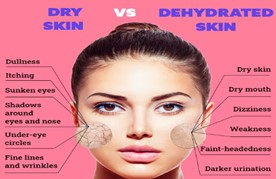Contribute
| How To Hydrate Your Skin From The Inside-Out |
Geetha Patil and Dr. Kirankumar Rathod
08/23/2023
The arrival of winter brings with it cold temperatures, dry air that makes our skin even drier. There is a difference between dehydrated skin and dry skin. Dehydrated skin is not a skin type, but a skin condition. Dry skin is essentially a skin type, like people have dry, oily, normal, or combination skin types, which happens due to lack of sebum (oil) in the dermis. Dehydrated skin, on the other hand, indicates a lack of water and moisture in the dermis, making it a skin condition. It is a temporary state, any skin type can experience. A damaged barrier means loss of moisture and signs such as tight, dull, and papery can be linked to dehydration. How to tell if you have dehydrated skin? A quick way to determine if your skin is dehydrated at home is a “pinch test†of your skin. If it looks wrinkly or does not bounce back to its normal position, then it is more than likely dehydrated. What factors are responsible for skin hydration? Several factors such as constant hand washing, use of sanitizers, excessive ultraviolet exposure, or cold wind, low temperatures, aging, loss of collagen and glycosaminoglycans like hyaluronic acid ((HA has unique capacity in retaining water) affect skin ceramide composition, potentially leading to increased trans-epidermal water loss and negatively affecting skin hydration. For example, going from a heated room to the biting cold outdoors What causes dehydration of the skin? Our skin especially our facial skin gets stripped of moisture by air conditioning, cold weather, lack of sleep, not drinking enough water, too-hot showers and skipping your gentle skincare routine. It is important to remember that all skin types can become dehydrated. How to treat a dehydrated skin? Dehydrated skin is always a temporary condition and it can be reversed with a modification in the superficial layer of the epidermis that lacked water and in turn disturbed the skin's barrier function. There are some long and short-term guidelines for keeping your skin hydrated and getting your complexion back on track. Dehydrated skin meanwhile needs two-pronged treatments. Firstly, hydrate your skin from the inside out with taking plenty of water, juicy fruits and vegetables. Avoiding alcohol and coffee for a little while might help too. Secondly, skin also needs moisturization (oil) in order to create a barrier, keeping all that water locked into the skin, and stopping it from escaping. The heavy texture and nourishing properties of oils impart moisturizing and soothing benefits to the skin. Vatta dosha skin types have generally dry skin. Therefore, sesame oil and jojoba (wild hazel or goat nut) oils can do wonders. For Pitta dosha, one can use ghee, and coconut oil, which is known for its anti-bacterial and anti-inflammatory properties. Kapha-type skin on the other is naturally oily. So, in order to prevent excess oil secretion, sunflower oil is a better option that helps moisturize the skin without overdoing it. Then comes the targeted treatments to get your skin back to its former, plump and dewy glory. 1. Drink water! 2. 2. Increase your Vitamin D consumption (Mushrooms, Orange juice, Eggs, Salmon, 3. Milk, Tofu, Cod liver oil, Raw Oysters). 4. 3. Eat collagen-rich foods (Chicken, chicken, Citrus Fruits, Legumes, Peppers, Leafy Greens, and Bone Broth). 5. Add foods rich in Omega-3 to your diet (Fish and other seafood, Nuts and seeds (such as flaxseed, chia seeds, and walnuts) Plant oils (such as flaxseed oil, soybean oil, and canola oil) 6. Look for good fats and protein (guavas, avocados, apricots, kiwifruit, blackberries, oranges, bananas, cantaloupe, raspberries, and peaches, Lima beans, green peas, spinach, ash gourd, sweet corn, artichokes, Brussels sprouts, sweet potato, asparagus, broccoli, kale, mushrooms and avocado) 7. Look out for Vitamin A-rich foods (cantaloupe, mangos, papaya, orange, many of the squashes, carrots, leafy green vegetables (kale, spinach, and broccoli), sweet potatoes, tomatoes, red bell pepper, pumpkin, and maize, beef, fish, milk, and eggs). 8. Supplement skin with antioxidants (Broccoli, spinach, carrots and potatoes, Blueberries, cranberries, strawberries, blackberries, raspberries, even goji berries, are all at the top of the list of antioxidant-rich fruits). 1. Limit or avoid coffee, alcohol and. smoking 2. Review your skin care routine. Use a hydrating moisturizer. Always use sunscreen when going out in the hot sun. 3. Do not wash your skin with hot water. Limit showers to 5 to 10 minutes, and use lukewarm water. 4. Get 8 to 9 hours sleep. 5. Use vitamins and other nutritional supplements vitamin C, vitamin D, and fish oil, collagen What are the signs of intracellular dehydration? How do you increase inner cellular hydration? Increased thirst, dry mouth, light-headedness, fatigue, impaired mental focus, low urine output, dry skin, inability to produce tears, sunken eyes are the signs of dehydration. A bit of salt (sodium chloride) and sugar in your drink can help fuel your body with some electrolytes and glucose to help promote proper fluid balance and cellular hydration. How long does it take to fix dehydrated skin? Once you eliminate products that damage your skin barrier, and follow routine skin cares practices it will begin to heal naturally on its own. In general, minor skin barrier damage may take a few days to a week to heal, while more severe damage may take several weeks to months to fully recover. However, rebuilding the skin barrier is a continuous process, and it is important to maintain a consistent skin care routine that supports the repair process.
by Geetha Patil and Dr. Kirankumar Rathod


You may also access this article through our web-site http://www.lokvani.com/


